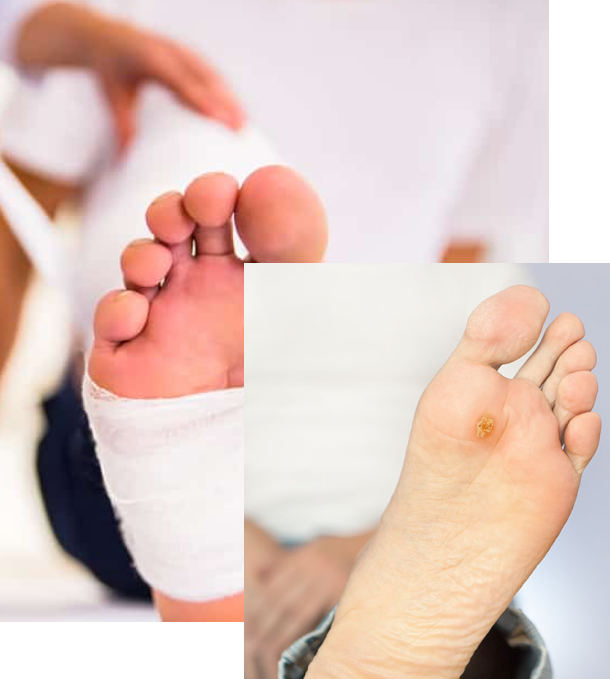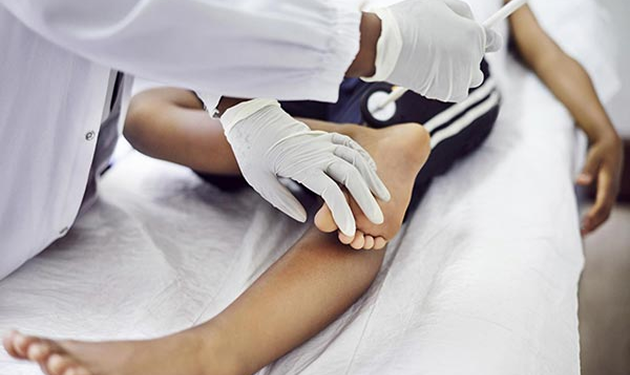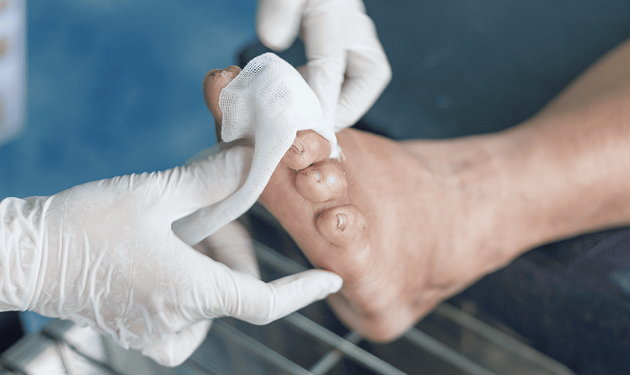Foot Infections & Wound Care

Foot Infections & Wound Management: Protecting Against Complications
Foot and lower-leg infections can escalate quickly—especially in individuals with diabetes, circulatory issues, or weakened immunity. A seemingly minor skin break, fungal overgrowth, or ulcer can evolve into a serious complication. At Dr. Michele Selsor’s Pinellas Park practice, we emphasize early detection, aggressive care, and collaboration with specialists to preserve limb health.
Diagnostic Strategy

History and clinical assessment
Onset, symptoms (redness, pain, swelling, discharge, warmth).
Underlying risk factors (diabetes, immune compromise).
Documentation of wound size, depth, morphology.

Laboratory and imaging investigations
Wound culture, Gram stain, sensitivity testing.
Bloodwork: CBC, inflammatory markers, glucose levels.
Imaging (X-ray, MRI) to assess bone involvement (osteomyelitis).
Vascular studies (Doppler, ABI) if impaired circulation suspected.

Why Foot Infections Are High Risk
- The foot is distal and often has limited blood supply, making fighting infections harder.
- Underlying conditions (e.g. diabetes, peripheral vascular disease) can mask symptoms or delay healing.
- Infections can extend to bone (osteomyelitis), deep tissues, or bloodstream if untreated.
Common Types of Foot Infections
- Bacterial cellulitis or abscess.
- Fungal (dermatophytes, yeast).
- Paronychia or nail fold soft tissue infections.
- Ulcer-associated infections (especially in diabetic patients).
- Skin breakdown, maceration, intertrigo, abscess formation.
Treatment Protocols
Acute infection management
1
- Debridement of necrotic or infected tissue.
- Drainage of abscesses.
- Empiric antibiotics, then tailored by culture results.
- Topical antimicrobials as adjunct.
- Offloading and protection to limit stress on the area.
Advanced wound care
2
- Moist wound healing principles using dressings, hydrogels, bioactive agents.
- Negative pressure wound therapy (NPWT).
- Use of grafts, skin substitutes, or biologic scaffolds (e.g. SurGraft XT used in Dr. Selsor’s practice) Specialty Wound Care.
- Adjuncts: hyperbaric oxygen therapy (if available), offloading casts.
Chronic and complex cases
3
- Multidisciplinary collaboration with vascular, infectious disease, endocrinology.
- Revascularization referral if perfusion is limiting healing.
- Surgery for debridement or resections, as needed.
- Long-term monitoring and preventive foot surveillance.

Practice & Local Insights
- In Florida’s warm and humid climate, skin maceration and fungal overgrowth are more prevalent, making infection vigilance essential.
- Dr. Selsor’s practice base in Pinellas Park (central to Pinellas County) ensures that patients across the Tampa Bay area can access specialized foot infection care drmicheleselsor.com+1.
- Use of advanced wound care technologies (e.g. dual-layer extracellular matrix products) positions the clinic to manage challenging cases effectively Specialty Wound Care.
If you discover a stubborn sore, discoloration, swelling, or drainage on your foot or lower leg, contact us immediately. Early treatment can prevent serious complications and support full recovery.
